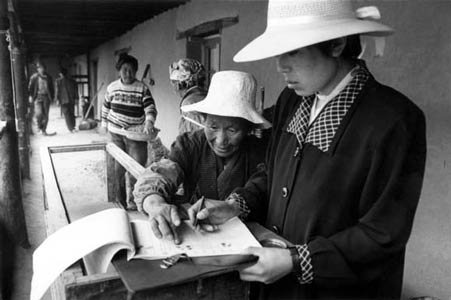 |
|
Master Chuchok-la |
THF is providing vocational training for an increasing number of Tibetans. By learning traditional carpentry, masonry, painting and metal work, the ancient building skills and arts are not only revived, but passed on. There are still no facilities for higher technical education in the Tibet Autonomous Region. New building is done almost entirely in low quality concrete, requiring only legions of unskilled
labourers, and causing further erosion of traditional skills. Unfortunately, some skills already appear to have been lost, and it becomes more and more difficult to find enough masters who learned their trade before the dismantling of the traditional guilds. THF went to look for an additional master carpenter in the villages around Lhasa, and finally, in Nyemo (formerly famous for excellent carpentry), a very skilled master from a long line of carpenters was found.
The training of a water and sanitation team, including basic training in plumbing, has proved very successful so far. Funded by the Canada Fund (see chapter 4), the team of ten Tibetans has not only done some very impressive installation works in 1999, but members have already had jobs in their spare time, fixing toilets for private homes. THF architect Ken Okuma has given basic training to a small group of Tibetans in safe and proper electric line planning and installation.
|

|
|
twice daily all THF workers
have to mark the salary list. |
With extra funds available for training in 1999, it was possible to hire and train a second Arga group (the traditional flat Tibetan roofs consisting of stamped and oiled clay are locally known as Arga roofs). The apprentices who were hired for this work consisted mostly of young women who recently lost their work or place of residence (for example in a monastic community). Part of the funds also helped the carpentry workshop. In 1999, the main workshop location has been
Merunyingba, as the rehabilitation of this historic monastery required a multitude of specialised skills. Hundreds of people applied for a job or an apprenticeship at
THF, many from the villages around Lhasa and in the wider Kyichu River Valley.
The Trace Foundation funded the training programme, for water and sanitation, carpentry, masonry and mural conservation, with $13,570, in addition to the training activities at Merunyingba (see 2.4). The Ford Foundation also supported our general vocational training programme with $3,040 for the carpentry workshop., in addition to the Arga training at Merunyingba (see 2.4).
Part of the training programme consists also of administrative and planning works. THF aims to devolve more and more responsibilities to local Tibetans, who do increasingly more and more accounting, buying and day-to-day handling of construction materials, and making and checking the salary lists (see photo). Ken Okuma has improved the computerised accounting system for
THF, and chief accontant Yutaka Hirako is training local staff in using it, with support from Trace Foundation.
THF conservation architect John Harrison is continuing with his training of four local people in architectural survey and documentation (see chapter 8).
 |
|
Arga teams consist of up to
20 women. After preparation by grinding the Arga mineral into
different sizes, each section of a roof has to be continuously
stamped for up to a week before a mix of oil and resin makes the
surface waterproof. |
|